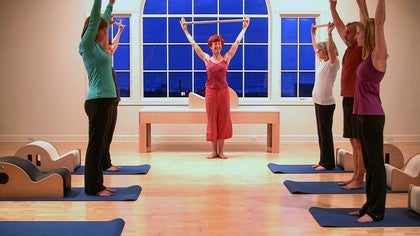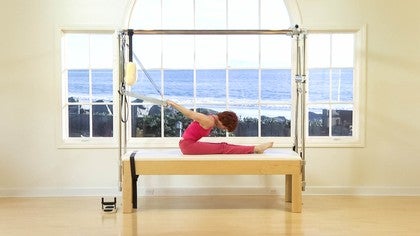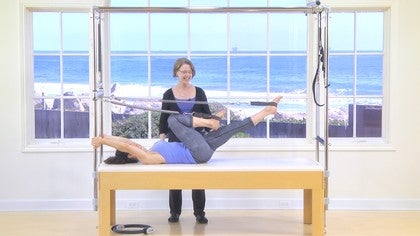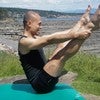Description
About This Video
Transcript
Read Full Transcript
Hi and welcome. I'm Rachel Taylor Siegel from the [inaudible] center in Boulder, Colorado. This is Jennifer Weiss, my client. And what we're going to do this afternoon is is practice up beginning intermediate mat work. However we're going to employ the springs when we can to show how the use of the springs can make even the exact same choreography easier for the client, for yourself as the practitioner, and even if you don't have it all the time, once you have felt it, you can replicate it to the best of your ability. And that is how we build uniform development. For example, you're doing the hundred and it's really hard to hold your leg up, your legs up and your neck gets tired or your hip flexors get tired. With the law, with the springs that we're going to use, we can eradicate some of that and then you can go longer building more endurance, but also you can go deeper, better, richer because you're already strong.
Muscles are not having to overwork and therefore the springs are helping you to find something you would not find otherwise and that's the great benefit of the springs. Wherever they are in the plotters method. Joe made spring work to be like extra muscles so that they challenged you sometimes but they also aid you and they usually they age you by replacing the muscles that are already the already strong that you really don't want to keep strengthening. And so when you make use of them you get to use the opposing muscles or at least other muscles and build strength there where you may never have gotten the chance otherwise. To do that though you kind of want to know what the job of the spring is at any given moment. And I will try and suggest that as we go along so that you don't fight the spring or let the spring kind of bully you around but that you are working with it like partners in dance or good marriage partners where you support each other and you come together to work in unison to create a product that together you can make more better, something like that than if you tried it alone. Okay.
So when we put the springs on Jennifer and she tries to, and she does the hundred and the roll down, et Cetera, we want those springs to be helping her. We want to make sure that they are, and so how do we know as practitioners or teachers, if they truly are doing that, if they're doing their job, first we have to decide what their job is. Is it holding up the way to their arms? Is it giving them the ability to not have to use certain like Pec muscles, deltoid, muscles? Is it make it making it easier for them to use opposite muscles that hold the legs down on the mat, for example.
But we also have to know is it truly working? So one of the great ways we can know on ourselves if using the springs is truly working the way we wish it to is if your abdominal muscles turn on automatically, doesn't have to be a big 100% fireworks kind of turn on, it can be 5% 2% even more. And you know you're on the right track. Okay? So if you feel your tummy turn on better, you know you're doing a better exercise for yourself. So as we use the um, equipment, I'll try to point that out so that you can see it on Jennifer's body maybe and sorta feel it on your own. Now we have, um, a balanced body Cadillac here, but I have chosen to use a little heavier of arms springs that we have at the plot is anytime. So we're using grots arm springs for the, those kind of exercises, but we're going to be back to the blue leg springs, um, from balanced body.
But that's just to let you know why you're seeing different things here today. If you don't have those, do not worry at all. Whatever you have can work as long as you work with it. Okay, so I'm going to start Matt workout by by having Jennifer lie down with her head towards the end of the arm springs and she can begin this exercise. Um, usually when you're using the Cadillac, you decide where to lay by putting your hands about eight inches up on the poles and having your arm straight. That tells you about where to be for almost every single exercise. All right?
She can have her long legs down and straight on the mat or she can bend them and plant her feet. It's up to her. Or if you're a teacher watching, it's up to you deciding what makes the best, what pulls her belly and the best for her. All right, so we're going to give her the um, arm springs and we're going to start the hundred with supine arm springs. And I'm going to ask Jennifer to start with her elbows bent and just do a few arms springs first, kind of get the feel of them. So obviously the spring is hooked behind her, which is going to pull her arms towards it. It's hooked above her, which is going to lift her arms, whether they're straight or bent up in the air. So we know those two things about the arm springs that is going to translate through her shoulders into her shoulder girdle, lifting it off her rib cage slightly so she should get better breathing, bigger inhales, and therefore better exhales. So if her belly turns on better than we know that she's getting a better exhale and if she gets a better exhale, we know she's going to get a better inhale.
So the same thing will be true for you at home. All right, so if you would, again, just do two. And she does that on the inhale, she pushes down, the springs are pushing her arms that way. On the third one, she's going to curl her head and shoulders up and lean her spine forward from here into the handles, elbow straight wrists, more straight, [inaudible] and hand straight. So now as she pumps, she has to pump down more than up. The up comes naturally, the down she has to work and in that sense she's going to get more upper abs, right? And then if you wish, you can extend your legs up and out for the hundred. Now you'll notice when she has these springs pushing back into her shoulder, strengthening them and giving her something to push and lean upon. She has a less tense neck.
And if she truly takes these upper vertebrae and leans them on straight riffs on the handles, you should be able to see her belly go in more and the exhale deeper. No, honestly done. Then the news ban the hair arms and put your head down good. So there's the hundred done with some arm springs. It's not the classical one with the roll down bar, but it is a way of doing them.
So Tommy enrolls you up and now we're going to turn her around. We're going to use the same springs, which are also the springs for the roll-down bar. And instead of doing the roll up, we're going to do the roll down. And the reason we'll do that is because it's easier and the springs help the client in the same way they did a moment ago. So they pull the client up and they pull her forward and so she doesn't have to do that job. And in that case when she doesn't have to do that job, if it were hard for her, then she gets to not feel that difficulty and gets to concentrate more on something else, which she might not get to concentrate on if something were really difficult to do.
So the spring above and in front of her holds up her arm weight. So all she's got to do is stay holding onto the bar with straight elbows and keep her arms in her shoulders, which by the way, I should turn on her upper abs. She's rounded forward a little bit. Spring starts home ish. Okay. But not a big deal. Right? And then as she starts rolling back, if you trust the spring to pick you up and hold you up, you really get to drape your spine back vertebra by vertebra onto the mat, exhaling as you go. And then the springs job is to turn her tummy on, pick her head up and pick her spine up so she doesn't even have to work hard to pick her spine up.
So the goal then of rolling like a wheel becomes much easier. So she starts at the bottom, opening the hips, say chrome, lumbar, thoracic, all the way down, exhaling to finish. And then if she can keep her arms in her shoulders and not let them come forward, but keep them knitted in where they should live, she'll have her belly on even better. My right, good. And then that belly will lift her chin up. And then if she resists up just a little, the springs will definitely turn her tummy on, make more wrinkles in your shirt. As you exhale, those wrinkles will translate into a better exhale.
Hotter consists more consistent. Every atom of air out like Joe asks us, etc. If we want to make it more difficult, we'll bring the right hand in the middle of the bar and we'll wrap the left arm around the ribs. Still rounding forward gently. So now if she holds this bar, whether the thumb is opposition in opposition or not with more cells. So if you as the client put more of your hand through out on your extra muscles, you're going to get a richer experience even yet.
So if you have the palm constantly engaged with the bar, you're going to get her rich, your belly, Richard's shoulder girdle strengthening. If you keep the elbow straight as you should not letting these spring energies dilute through the elbow, but coarse all the way through into the body, you're going to get a stronger belly and a stronger spine. So all those little details can help to give you more products, sooner, more success sooner. Okay. Again though, only a few percent difference is it is exciting, doesn't have to be 100% by any means. You need to give the body time to adjust to any new change and uh, weave itself through the whole body so that it is accepted and made use of correctly. Okay? So otherwise the roll down is exactly the same, just one straight arm in the shoulder. She rolls the pelvis back for her arms and then the sacred and the spring, because it's pulling her this way would shove her straight into the chrome poles.
And if the chrome poles weren't there and she put her legs together in the middle, it could slide her straight off the Cadillac. And so we determine now arm and shoulder gives you upper abs, which picks up your chin. Inhaling to start and roll. Exhaling to round and squeeze out all the air. Straight elbow. Good job. Change arms. And so what is it in her body that resists or meets the spring energy so that she doesn't slide off the center or so that she is pressed gently into the foot, into the uh, chrome poles. Okay, I'll leave that as a question for you to think about.
But as she comes back, pulling the bar through her, this starts first, second, third, fourth. As she rolls back, her heel should stay. Exhaling the breath. The arm pulls the bar in to the shoulder, right? And then that Tommy lifts the head and picks one vertebra up after another, peeling it like a necklace, a Pearl Necklace off of k. One more time, Jen.
A few would pelvis first say garage girl, low back Ribeye, rib X. Hell Yep. Cruel. Hale. Every atom of air out of you. Good. Nicely done. And rest. Good. So if the roll up, which admittedly is hard to do for beginners without knee bending or not using the bar or starting halfway up or something, and we have on the Cadillac the roll down bar, this is how you can replace it. Okay. We're going to swivel around and we're going to do single leg circle in the single leg circle. We will use leg springs and we're going to use them in the, I call it the archival version because it's from the 1940s and it came from this film that we found like 45 extra exercises that people didn't, weren't doing.
So when you do a leg, when you do a spring exercise, that's from the archival uh, period that even as classical you will put the, the spring attached about head heights when you're sitting on the Cadillac about head heights, give or take airing up or down depending on the exercise. Okay, we're going to cross over. It's probably the only time in polite that we do something this odd. We're going to cross over and I've put on these rubber hairbands to snug the foot strap against her in step so that she does not have to worry about losing the strap in the least. Therefore she can focus on other things that are more valuable.
So she's going to point her foot in. Nice alignment today. Would you like to do turned out or a parallel journey? Turned out a little bit. Okay, arms are going to start up on and whatever your favorite way pushing the poles apart, pulley or away from you pulling the poles into you, pulling the polls apart from each other and in all of those ways are valuable. As she points her foot and puts a little tension on the spring she start, she does not have to hold her leg up the spring, holds it up. The spring flexes her hip, so she doesn't have to use these muscles right in here that everyone loves to overuse. But what she does have to use are the opposing, the hamstrings, the inner thigh, and the outside of the hip.
So as she starts her inhale, she crosses her body, picks the hip up, right, pulls the left foot to the right foot, brings the hips back squarely upon, comes out to this side without extra turnout or extra turn in and returns. Exhaling dead center above her navel. Okay, so it's single leg circle as we know it bigger maybe because we can with the springs inhaling crossover and pull down, open to the side and exhale. Good, Eh, hell good. So as her hip pushes the leg down and controls itself side and opposes maybe resists, uh, just a little, not necessarily slow like I just did, but just a little, she's going to get more abdominal muscles last time. This direction. Inhale, here's that hip action control. Start your ex and feel the belly.
Finish it off at the arrival of the foot. And then five and reverse. Inhale down around Tommy and hiphop and over hot exhale rolls you from the top of the spine to the bottom. Inhale around and x bell the, and this exercise is preparing us for sidekicks. So she gets a little a flection in her spine here. Nicely done. And last one. Oh, round, hot, exhale, tummy in and legs center. Good job. Bend the knee, take that foot off and we'll change sides.
Did you like that, Jennifer? That exercise feels so good because it really gives you the chance to open up your low back and to feel the wonderful length and stretch of the as in the belly muscles from the inner thigh of the, of either leg all the way up to the spine. So sometimes it's hard to find those deep, deep feelings and when you use extra muscles, then you get a better chance at finding the things that have been weak or have been elusive. So she points her foot gently. She turns out a little bit at the hip and she starts crossing over. Inhaling, pulls it down, stands in it the whole way, no matter where it is. An exhale center in with their little faster down around an expel, hot and fall. Inhale, push. Good.
She gets to decide and how many vertebrates she's going to lift off the mat. She gets to decide every aspect of it and the controlling and how much effort she uses. At any moment. Okay. And reverse. So when you use springs and you are working with a partner, extra muscles, it puts a whole other realm of arena of information in the client's body and mind. So this is two circles around she stand, you stand forth, you stand forth deep into your hip, into the circle, into the spring. Then you bend your knee, you take the strap off your foot and be very careful that you hold onto it well so you don't drop it over your face and let it go behind you and then Tummy and crows you up. Now when you're doing your workout, if you want, there are many exercises that I am not putting a springs on. For example, we're going to do rolling like a ball right now and I, we could squeeze the magic circle, we could figure out something screwy to add springs to butt, but I'm not interested in making things more difficult. I'm interested in actually the springs and their extra muscle role to only aid us when they can very readily.
So let's do a just a few of rolling like a ball. You're going to bring your sitz bones to your heel, plant your feet. A few would pick your sits bones up and burning them forward and then wrap with your belly. Good. And since you felt the arms in supine arm springs, you have a stronger shoulder and upper back. Since you felt the legs in the springs, you have stronger hamstrings and hips.
So all that should feel different to you. Now when you do rolling like a ball. Okay. So as you inhale, you roll back to your blades as you exhale forward. Inhale to the blades only an exhale and inhale, roll back, exhale forth. And only one more. Let me hear the ex. Yes, so valuable when you do that. Isn't that nice? Yeah.
So then after rowing like a bone, what do you do next? Single leg stretch. Double leg stretched the belly busters. Okay, so we're going to lay down on your back. We're going to put the leg springs back on, but this time as we put them on or before we put them on, actually we're going to make sure that they're at a regular leg, spring height, hooked at irregular legs, Spring Heights. Okay. We don't absolutely need those, uh, rubber bands. They do help to make you feel very confident that you're not going to let the strap slip off your foot, for example.
And especially when we'd come to the outside leg springs, then we'll see the real value in them. Okay, so I'm bringing them down to the hook about where you would use leg springs hooked on your Cadillac. We'll start with the hands on the pole. So this exercises done without the head up at first, at least, and with the hands on the Poles. Now since the springs are above her and behind her, they're doing the same job that they have done before. So she should be able to use hip flexors, less hamstrings and inner thighs much more and therefore belly more without tensing her back or, or whatever her favorite 10th and tension places are.
You'll bend your knees to your chest. Legs are parallel throughout and single leg stretch and double leg stretch. And we're gonna see as we go along, Jennifer is going to see just how much does she really need her arms up there. Obviously. And Matt, you don't put your arms on the pulse system, you use them on your hands, but here you cannot because they would get in the way. However, you should be building a lot of strength in your pelvis and in your belly such that you have, um, you can withstand the springs pushing you. So we'll see partway through if she feels capable of bringing her arms down and lifting her head. We'll do that. Okay.
The springs will stay on the outside just as your legs are parallel in the mat exercises. As she inhales, she stretches one leg out long and low. Ben Zit and stretches the other one. [inaudible] and in math they're all, they alternate simultaneously. So here that can be true as well. So you can see if she resists bending in just a teensy bit, not even slow, but just with the thought, she's going to get a little more belly, less back tension. Right? And if she thinks about letting her hands go, we're gonna feel more in the belly, right? Nice. Keep your knees on the inside. [inaudible] good.
And bring both knees to the chest, exhaling. And then the double leg stretch. Inhale, press out. We see the deep scoop on the inhale. Resist just the little as you exhale. Bend. Nicely done. Inhale. So here we see this gorgeous scoop. Easy back, right, an exhale. So if the job of the springs is to hold her legs up, whatever extra work she you might do in that moment to help hold the weight of your legs, you don't have to do it anymore.
So see if you can put your hands behind your head and pick your head up as you resist gently knee bending on the inside and press out and resist home night. Listen to your wonderful exhale. Yes, she lifts the hips up the springs. Bring the knees to the eyebrows. Very good. Now lift both legs up towards 90 and do the scissors one leg down in the opposite down. Good. So 50 50 weight on both legs, 50 50 into a thoughtfulness on both legs, resisting up just a hair.
So you don't do the job of the spring, which is to hip flex you, you are controlling it and it should give you more Tami. When you control it both legs up, squeezed together, double leg lower. So straight legs up in the air and straight legs down. Inhaling, exhale up. Nice. So the weight of the head is held by those arms.
She's leaning forth into the spring and controlling the [inaudible] rise. Very beautiful. Last one, she has most beautiful scoop and Ben's knees and relax. Nicely done. She does really good. Good. So she'll take those off and after that would come up and do stretch. And we're going to do an archival spine stretch. So we're going to take the bar and set it at that heights where it is.
Give or take head height when you're sitting on the Cadillac. That take up a little bit more. Okay. And then she's gonna take hold. Now, sit back a little bit if you would. And this particular exercise we can mimic spine stretched by having our feet open in the v with the flection. Or we can do it like they did in the forties bringing the legs together so that as she spine stretch forward, she's going to go three different places each time, farther than the last. So you inhale here, you curl the chin to the chest, you hand stand, you go, exhale, exhale, and even exhale. Now the spring is going to push you up.
It's going to help you wreck you, and then you curl. Exhale, push you down and pushing down on that spring, going further and further, right? And then resist up just a teeny bit and let those springs, I'm for all your posture. Oh, I'm sorry. One more time. Ex Hell for their band in hell. Let it push you. Leave wrecked and rest. Nice.
So it builds more strength than the ABS in our thighs. Hamstrings. It stretches the spine often more than you might buy yourself. It's altogether more strengthening when you use, um, springs to help you. But it's also more balancing. So if someone picks themselves up with their back, if you feel like I pick my back up when I inhale, then using the springs will keep you from doing that to a great extent and you'll be able to feel your belly more because you're relating to this springs which are, their job is to pick you up.
So your job is simply to control them, if that makes sense. We're going to skip the spine of the saw, but turn around and lay or lay down on your tummy for Swann. You can do saw, we're just gonna skip it today. So she has her hands on the bar, straight arms, legs together and straight feet pointed. And the bar here are the springs here are holding her arms up in the air.
So that's already a stretch for the short, for the front of the chest and a bit of work for the upper back. She, her job is to keep wrist and elbow straight here as she inhales. She does the traditional eyes, nose, chin, chest forward. You will bring the bar down towards the mat as you lift your legs, eyes, chin, and chest. Right? And as you exhale, resist just a little bit. As you let the bar lift your arms before you bring your eyes down.
So as you inhale, you follow the Lady Bug of cross the wall and up the right and you lift and stand upon and then stand upon it even as it goes up. Right? Exhaling your breath. Nice. Then again, twice in with the air. So the springs job here is to hold up her whole arms and upper body so her back does not have to work unduly. Exhale, resist just slightly. Yep. And squeeze your air out last time in with the air, right. Stand more firmly on it, lifted off the mat and stand on it.
Nicely done, Jennifer. And then exhale, release it forward with control and up and forehead comes down. Very good. You can let go of it. Tummy in and sit you back on your heels and rest. Okay, so we're going to skip single leg and double leg kick, but we're gonna do, um, psychics. So we'll take down the roll down bar and we'll set the spring to a regular sidekick setting and lay on your right side with your right elbow here, hand up.
And those of you who remember or more advanced know that that bent bottom arm can eventually straighten so that you are sent further away from the spring attachment. And so it makes it harder. All right? So as this, as you pick up your spring and put your foot in it,
So she gets a decompression and a strengthening at the same time she picks her leg up hip heights and she inhales to the front and exhales to the back. Good. So why would you choose to use a springs? They make the exercise easier to do with the muscles that are already strong, taking a backseat and with the muscles that aren't as strong or uniformly developed, being able to come to the fore and do more work. So here are the belly, the so as lifts her leg rather than her quad here, her hamstrings pull the spring back and she gets this gorgeous length through the tummy that supports her spine. Inhale to the front, exhale to the back so it feels really delicious all the way through your body and go a little faster for the last two and exhale and x and they nef and bring the legs together. Good. Turn your leg out.
[inaudible] this hand is palm down. Good. And if your neck bothers you a little bit in this position, laying your head down, you can put a pillow between your head and your arm. We should see that the shoulder girdles, one shoulder stands on top of the other one. Hip stands on top of the other. That part doesn't change, but the spine can change as well as the leg. All right, so as she kicks up, she doesn't have to lift her leg from what's usual. And as she pulls down, she gets to strengthen the opposing muscles.
So the spring lifts are, and she controls it. She pulls down and strengthens the inner thigh, the deep six, right? The lower glutes. And you can see at the moment she starts pulling down her belly. Tony, even better. So at the moment of the highest up, can you keep it in there? What would that take an exhale down? One more time.
Beautiful. Exhale down. Nicely done, Jennifer. Let's take that off and do the other side. So the one disadvantage of doing a mat with springs is that you can't keep the flow going. However, I'm kind of faking it here by putting all these possibilities together in one class. So you might choose a couple of the exercises that serve you best, where you get that weird clunk in your hip or in your sake or, and when you do single leg circle you'd put a spring on or where it's really hard not to overuse your quads and come not and therefore not bend a few vertebrae at a time. Then you might use the roll down bar and those springs support will give you access to what you have not been getting.
And then you can transfer it into your mat workout and you'll be s you'll have more experience, more capability, more uniform, more balance. So it'll be easier to, uh, get even better. Okay. So she lifts up hip heights, she brings her leg to the front and hailing and bend your spine just a little bit. Yep. And then her hamstring hip extensor to the back. She works like crazy here, but the hips and shoulders stay square. Inhale Front. Then exhale back and inhale friends and exhale back. Good. So this spring holds her up.
So her quads up at top do very little or do very little by comparison to what they might have done, I should say, but her hamstring and you can see in this view how beautiful the ham and low tush work pulling that leg back and standing way out in to decompressing her spine last time. Nice dinner for exhale hot yes, and bring your legs together. Good. And then turn your leg out. You can see her rotation just like you turn out and you inhale to rise and you exhale pull down. So the risings not hard except you just got to control the squirrely spring. They're coming down, you're pulling all these coils apart, you're strengthening the inner thigh, the pelvic floor, all, all side legs, kicks and springs are really great for pelvic floor strengthening by the way, as well as hip strengthening and waste. Good. Last one. Very nice. And enough, she bends her knees. You'll take your spring off your foot, make sure that you don't let it drop on your face and come up. Okay.
So after that we're going to do teaser and we're going to come to the other end of the Cadillac and use the um, rolled it or the, um, push through bar. We're going to attach a string from the top and if that feels light, depends on your Cadillac and what you've got. What do you like, Jennifer? Do you like to? Yeah. Okay. Okay. So it'll be hard to pull it down. One. Let's do one. But I want them to be able to see your belly. We know on the spine articulating, so we'll see. All right, so we start scooch down half an inch, just all [inaudible]. We start with the palms right over the shoulder.
She bends her elbows and shoulders you've pushes through and her, she comes to a straight wrist and elbow with her palm touching. Because when you are using extra muscles, you want them to be as involved with the rest of your body as possible. So the more of yourselves touching those extra muscles of the strap and the bars, et Cetera, the more they will transfer into your body down literally every cell of your body. Until you know, however good you are to bring them to the sole of the foot or if you want them to stop in your hips or your tummy or whatever. So if your connection is weak, their power will be less than. All right? So as she bends, we watch, we watch our hands that they stay not gripping so hard. They can't swivel, but surrounding and embracing so that they connect.
She bends the shoulders and the elbows inhaling, she straightens the arms. Now at this point she's kind of pulling down a little bit this spring, which is wanting to lift her into her shoulders, which tones or Tommy, so you'll feel your tummy on, which will lift your head and then you'll curl the spine up, lifting the leg into teaser, lots easier than mat work, and then we'll roll back down using the spring to hold her up. She can deray per spine. She's more willing to free her hips and lay her legs down simultaneously with her head. One more time in with the air, curl at the Tummy, roll up, notice the beautiful wrinkles in her shirt. And then too does, let's do a version here where you bend your arms and lift them.
Since we don't have the other teasers, good palm fully on right, which will, by the way, show you if you have some tightnesses or weaknesses in your wrist, elbow, et cetera. Stay fully straight, double leg, lower inhale, exhale, nice. Inhale, exhale, beautiful by moral only hot knife, and then she lays everything down. Starting at this tape of the tailbone, steak crumb, head hits with heels, shoulders, abos band. She pushes out, but she's not just going to push through. She's also gonna let the spring stay in her body as part of the extra muscles. Not that it would be terrible if you didn't, but you get some thing that you wouldn't have otherwise. If you do so, if you end up in a handstand, if you end up still conversing with the spring bar here, you will have XL better than you might have.
You will have toned your belly better than you might have. You will have strengthened around the elbow, which is a weak place for a lot of people and lessened the use of your outer packs because the spring bar holds your arm up. You do not have to hold it, and instead built strength in the back of the shoulder across the upper back, which is often weaker, especially for women, but not necessarily often a weaker place. Okay, so she bends her arm, allows the bar to come off and tummy and sits up. Good. So then let's, you could do swimming. You can do any of the exercises that are common to you in your mat workout.
Don't hesitate. But we're going to finish with seal and since the theme has been springs and extra muscles, we're going to put the Jennifer's gonna use a magic circle. She's going to put it in between her lower inner thighs and then thread her arms through it underneath her heel and ankle so that it's not in the way, but it helps maintain her smallness, which is not quite rolling like a ball, but very similar. Okay? So as she squeezes her knees together, she gets in her thigh belly, just like if she squoze her heel together. So you can add claps or not, however you feel well back and forth and back and exhale.
Good. So squeeze the circle as you clap your heels. Nice. And then clap or not up back there. Yes. And big breath in. Big Breath out. Nicely done. Big Breath in. Last one. Big Breath out. Excellent. Rest.
Good. So good. Good. So these are some ways that you can use the springs, whether on the Cadillac or on the reformer, on the low chair, such that they enter you as extra muscles as Joe suggested, so that what you have been finding difficult or elusive now can become more available to you and therefore you can strengthen, uh, as, as he wanted, as we all want into a more uniform and balanced body. And in addition, because you're doing something, you unusual to what you've been doing and thinking of it as extra muscles, you'll also be building new brain cells, new synapses that you have to build whenever you do something new. So it's a really great exercise on every single level, body, mind, and spirit to add the springs in. And even if you just did one in your workout, you would feel the gratification and the, um, wonderful product from it.
Thanks.
The Successful Beginner: Other Apparatus Basics
Comments
You need to be a subscriber to post a comment.
Please Log In or Create an Account to start your free trial.



























